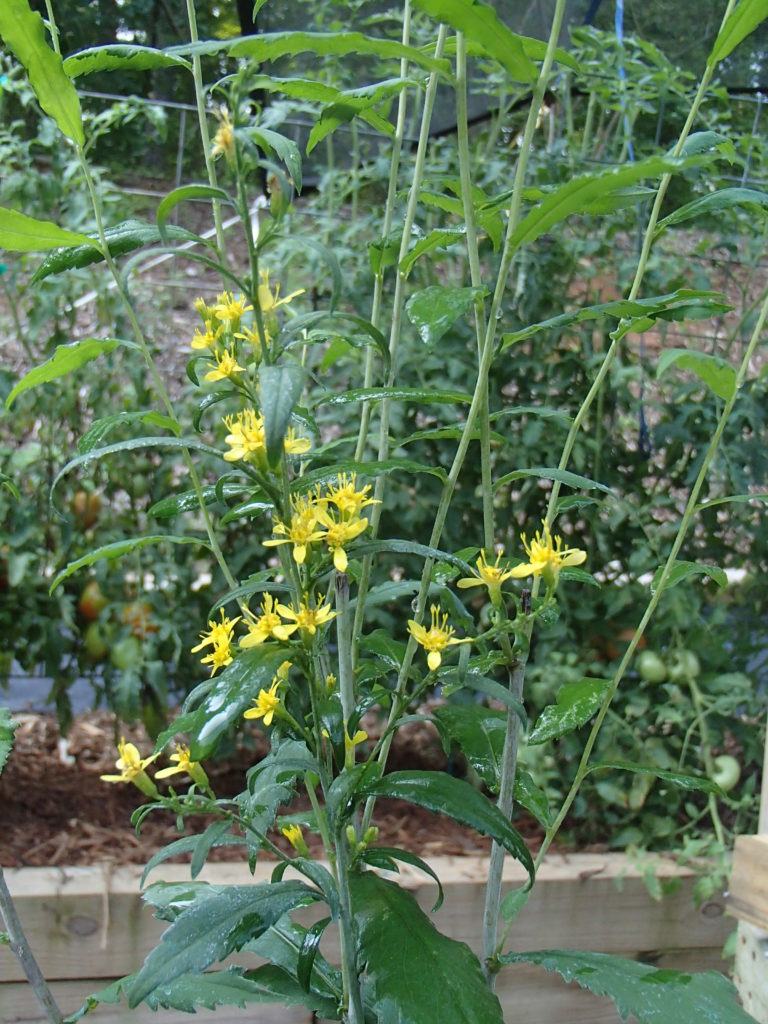Wreath (or Bluestem) Goldenrod could have been so named for its plant form, growing to 2-3′ in gracefully arching, mostly unbranched shoots with bright flowers positioned in the axils of leaves all along the stems. It is smaller and less aggressive than most of its cousins, and more suitable for cultivation in many garden settings. This species of Goldenrod provides yellow accents in the full sun garden and meadows but also in somewhat shadier — and drier — locations than can be tolerated by other Goldenrods. Not many flowers tolerate dry shade! This one is a fine cut flower, is attractive to many insects, and the seeds are popular with birds. It can form small colonies, but is not remotely invasive. Wreath Goldenrod is found in open woods and clearings throughout eastern North America, and in NC occurs more in the piedmont and foothills than in the mountain or southeastern coastal plain counties. Goldenrod pollen is not airborne and does NOT cause hay fever.
NURSERY HOURS
Wednesday: 10-4 Thursday: 10-6 Friday-Saturday: 10-4 Sunday: 12-4
Solidago caesia

Key Info
Scientific Name: Solidago caesia L.
Common Names: Wreath Goldenrod, Bluestem Goldenrod, Woodland Goldenrod, Axillary Goldenrod
Family Names: Asteraceae (Composite, or Daisy Family)
Plant Type: Herbaceous perennial
Flower Color: Yellow
Special Characteristics: Rhizomatous, Good cut flowers, Attracts bees, Attracts butterflies, Drought tolerant, Shade tolerant, Attracts birds
Additional Info
Habit: Wreath Goldenrod is a clump-forming perennial wildflower with wiry, arching stems above a basal rosette, mostly unbranched, green and smooth when young, becoming bluish or purplish with age with a whitish waxy bloom. The stems bear clusters of yellow flowerheads in the leaf axils, with a large terminal cluster. The root system is fibrous. In favorable conditions, individuals will form small colonies from underground rhizomes or self-seeding.
Height: 1 to 3'
Spread: 1 to 1.5'
Soil Conditions: Dry to medium, acid, circumneutral and slightly basic pH, sandy, loamy, clay, rocky.
Leaves: Leaves are lance-shaped, medium green, alternate, gradually becoming smaller towards to top of the stem. Lower leaves are up to 5 inches long and ¾ inch across. They are oblong and sessile, with smooth to toothed edges.tapered and sharply pointed.
Flowers (or reproductive structures: Tiny, bright yellow, daisy-like flowers about 1/8 inch across, typically with 3-5 rays per head surrounding 4-5 tubular disc flowers. Loose clusters (racemes) of up to 12 flowerheads appear in the leaf axils along the length of the stems, especially pronounced in upper leaf axils, with the terminal clusters being the largest, up to 3 inches long. Blooms occur in late summer to fall.
Fruit: The plume of fertile florets matures into a plume of small, golden brown, oblong achenes, each with a fluffy pappus that lends itself to wind dispersal in late fall.
Natural Distribution: Rich, deciduous or open woods, wood borders; clearings, usually in quality upland woods where oaks or other deciduous trees dominate.
USDA Hardiness Zone: 4 to 8
USDA Wetland Indicator Status in NC: FACU
Pollination: Bees, wasps, butterflies and other insects.
Wildlife Connections: Native bees, wasps and pollinating flies seek nectar and pollen from the flowers of Wreth Goldenrod, as the foliage hosts caterpillars of several moth species. Seed are eaten by various songbirds -- Indigo Bunting, Slate-Colored Junco, Tree Sparrow, Eastern Goldfinch, and other songbirds (IllinoisWildflowers.info). Although some sources claim some deer resistance, others report that White-Tailed Deer are especially likely to feed on the foliage of goldenrods in woodlands.
Propagation: Propagate by seed or division.
